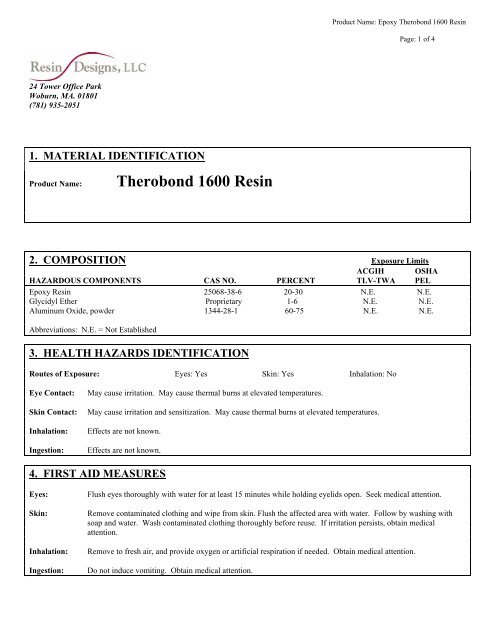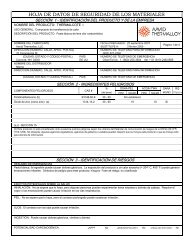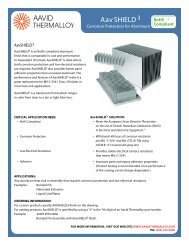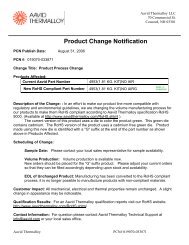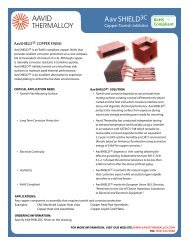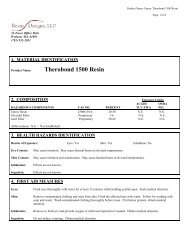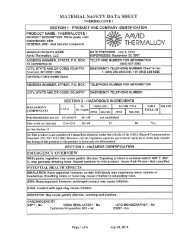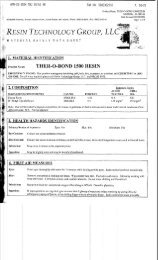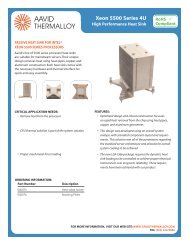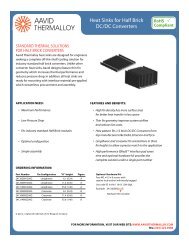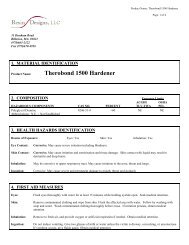Therobond 1600 Resin - Aavid
Therobond 1600 Resin - Aavid
Therobond 1600 Resin - Aavid
You also want an ePaper? Increase the reach of your titles
YUMPU automatically turns print PDFs into web optimized ePapers that Google loves.
24 Tower Office Park<br />
Woburn, MA. 01801<br />
(781) 935-2051<br />
1. MATERIAL IDENTIFICATION<br />
Product Name: <strong>Therobond</strong> <strong>1600</strong> <strong>Resin</strong><br />
Product Name: Epoxy <strong>Therobond</strong> <strong>1600</strong> <strong>Resin</strong><br />
Page: 1 of 4<br />
2. COMPOSITION Exposure Limits<br />
ACGIH OSHA<br />
HAZARDOUS COMPONENTS CAS NO. PERCENT TLV-TWA PEL<br />
Epoxy <strong>Resin</strong> 25068-38-6 20-30 N.E. N.E.<br />
Glycidyl Ether Proprietary 1-6 N.E. N.E.<br />
Aluminum Oxide, powder 1344-28-1 60-75 N.E. N.E.<br />
Abbreviations: N.E. = Not Established<br />
3. HEALTH HAZARDS IDENTIFICATION<br />
Routes of Exposure: Eyes: Yes Skin: Yes Inhalation: No<br />
Eye Contact: May cause irritation. May cause thermal burns at elevated temperatures.<br />
Skin Contact: May cause irritation and sensitization. May cause thermal burns at elevated temperatures.<br />
Inhalation: Effects are not known.<br />
Ingestion: Effects are not known.<br />
4. FIRST AID MEASURES<br />
Eyes: Flush eyes thoroughly with water for at least 15 minutes while holding eyelids open. Seek medical attention.<br />
Skin: Remove contaminated clothing and wipe from skin. Flush the affected area with water. Follow by washing with<br />
soap and water. Wash contaminated clothing thoroughly before reuse. If irritation persists, obtain medical<br />
attention.<br />
Inhalation: Remove to fresh air, and provide oxygen or artificial respiration if needed. Obtain medical attention.<br />
Ingestion: Do not induce vomiting. Obtain medical attention.
5. FIRE FIGHTING MEASURES<br />
Product Name: EPOXY <strong>Therobond</strong> <strong>1600</strong> <strong>Resin</strong><br />
Date of Issue: 01/09<br />
Page: 2 of 4<br />
FLAMMABLE PROPERTIES<br />
Flashpoint: 480 o F<br />
Explosive Limits: Not determined<br />
Auto - Ignition Temperature: Not determined<br />
Hazardous Decomposition Products: Carbon monoxide, carbon dioxide, aldehydes, acids, and other organic substances<br />
Fire Fighting Instructions: Firefighters should be equipped with full bunker gear, including a positive pressure, NIOSH approved,<br />
self-contained breathing apparatus. Fire-exposed containers may be cooled with water.<br />
Extinguishing Media: Use water fog, carbon dioxide, dry chemical, or an appropriate foam.<br />
6. ACCIDENTAL RELEASE MEASURES<br />
Ventilate the spill area, and evacuate if necessary. Absorb with clay, sand, or another suitable material, and dispose of properly.<br />
Clean-up personnel should use adequate protective equipment, including respiratory protection.<br />
7. HANDLING AND STORAGE<br />
Store in a cool, dry place away from ignition sources and temperatures above 300 o F. Avoid contact with incompatible materials.<br />
Some curing agents, if present in sufficiently large quantities, can cause exothermic reactions and runaway polymerization, yielding<br />
fumes, which vary widely in composition and toxicity. Do not breathe fumes.<br />
8. EXPOSURE CONTROLS AND PERSONAL PROTECTION<br />
Engineering/Ventilation Controls: General ventilation and local exhaust may be required to maintain airborne concentrations<br />
below the established exposure limits exposure when generating vapors or mists.<br />
Respiratory Protection: When local ventilation is unavailable and airborne limits are exceeded, a NIOSH-approved<br />
respirator, a supplied-air respirator, or a self-contained breathing apparatus is required.<br />
Skin Protection: Impervious gloves and protective clothing should be worn whenever skin contact is possible.<br />
Continued skin contact can lead to sensitization. Skin contact must be avoided. Once skin<br />
contact takes place it is important to remove material and wash contact area with soap and<br />
water. Contaminated clothing must be cleaned prior to reuse.<br />
Eye Protection: Chemical splash goggles or safety glasses with side shields should be worn as appropriate.<br />
9. PHYSICAL AND CHEMICAL PROPERTIES<br />
Appearance: Blue<br />
Boiling Point: >500 o F<br />
Specific Gravity 2.35<br />
Vapor Pressure (mmHg): 0.03 at 77 o C<br />
Vapor Density (air=1): Not determined<br />
Evaporation Rate: Not determined<br />
Solubility in Water: Negligible
10. STABILITY AND REACTIVITY<br />
Chemical Stability: Stable under normal conditions and use.<br />
Product Name: EPOXY <strong>Therobond</strong> <strong>1600</strong> <strong>Resin</strong><br />
Date of Issue: 01/09<br />
Page: 3 of 4<br />
Conditions and Materials to Avoid: Keep away from ignition sources and temperatures above 300 o F. Reacts with strong<br />
oxidizing agents, acids, and strong bases.<br />
Hazardous Decomposition Products: Carbon monoxide, carbon dioxide, aldehydes, acids, and other organic substances.<br />
Hazardous Polymerization: Will not occur.<br />
11. TOXICOLOGICAL INFORMATION<br />
This section provides toxicological information with regard to the pure form of the components indicated. This information can be<br />
subject to misinterpretation. It is therefore suggested that persons trained in its evaluation interpret this information.<br />
Epoxy <strong>Resin</strong>:<br />
LD50 Acute Oral Rat: 11.4 g/kg<br />
LD50 Acute Dermal Rabbit: > 20 ml/kg<br />
Eye Irritation: Driaze – 2 Rabbit<br />
Skin Irritation: Driaze – 1.6 Rabbit<br />
Note: Due to this product’s physical composition, the release or generation of dust is not expected to occur under normal conditions<br />
of use.<br />
12. ECOLOGICAL INFORMATION<br />
No data found.<br />
13. DISPOSAL CONSIDERATIONS<br />
Keep out of surface waters, sewers, and waterways entering or leading to surface waters. Notify authorities if any exposure to the<br />
environment occurs or is likely to occur. Utilize an appropriate disposal facility, in compliance with applicable federal, state, and<br />
local environmental control regulations.<br />
14. TRANSPORT INFORMATION<br />
D.O.T. Classification: Not Regulated<br />
Hazard Class: None UN #: None PG: None ERG #: None Hazard Labels: None<br />
I.A.T.A. Classification: Not Regulated<br />
Hazard Class: None UN #: None PG: None ERG #: None Hazard Labels: None
15. REGULATORY INFORMATION<br />
U.S. FEDERAL REGULATIONS<br />
Product Name: EPOXY <strong>Therobond</strong> <strong>1600</strong> <strong>Resin</strong><br />
TSCA:<br />
The chemical components of this product are contained on section 8(B) of the chemical substance inventory list<br />
(40CFR710).<br />
SARA Title III Information<br />
Date of Issue: 01/09<br />
Page: 4 of 4<br />
Section 313 - Toxic Chemicals:<br />
Pursuant to section 313 of SARA Title III, this product does not contain a toxic chemical in a concentration in excess of 1<br />
percent of the mixture, or 0.1 percent if a carcinogen.<br />
Section 311 / 312 - Hazard Categories<br />
Pursuant to section 311/312 of SARA title III, the physical and health hazard categories for this product are identified as<br />
follows:<br />
Fire Hazard: No<br />
Sudden Release of Pressure Hazard: No<br />
Reactivity Hazard: No<br />
Immediate (Acute) Health Hazard: Yes<br />
Delayed (Chronic) Health Hazard: No<br />
16. OTHER INFORMATION<br />
HMIS Hazards: Health: 2 Flammability: 1 Reactivity: 0<br />
NFPA Hazards: Health: 2 Flammability: 1 Reactivity: 0<br />
This information is intended solely for the use of individuals trained in the use of this particular system.<br />
<strong>Resin</strong> Designs LLC urges each customer or recipient of this MSDS to study it carefully in order to become aware of and<br />
understand the hazards associated with the product. The reader should consider consulting reference works or individuals that are<br />
experts in ventilation, toxicology, and fire prevention, as necessary or appropriate in order to use and understand the data contained in<br />
this MSDS.<br />
To promote safe handling, each customer or recipient should: 1 - notify its employees, agents, contractors, and others whom it<br />
knows or believes will use this material or the information in this MSDS and any other information regarding hazards or safety. 2 -<br />
furnish this same information to each of its customers for the product. 3 - request its customers to notify their employees, customers,<br />
and other users of the product of this information.<br />
The information contained herein is based on the data available to us and is believed to be correct. However, <strong>Resin</strong> Designs LLC<br />
makes no warranty, expressed or implied regarding the accuracy of this data or the results to be obtained from the use thereof. <strong>Resin</strong><br />
Designs LLC. assumes no responsibility for injury from the use of the product described herein.


